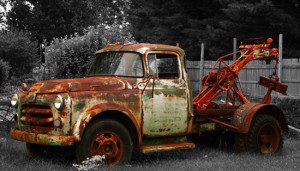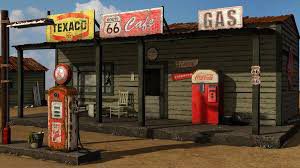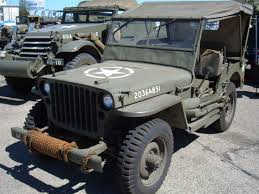
On the weekend, my wife and I motored north into what city people euphemistically call “cottage country.” We ended up at a friend’s cottage south of Sudbury. He’d invited us there to put our feet up at the lake and chill for a couple of days. Suddenly, however, in the middle of the weekend escape, our host faced a problem, an automotive problem, and he immediately got on the phone.
“Hey Rick,” my friend called into the landline phone. “You know that Nissan wagon of mine?”
There was a momentary pause, as I guess Rick, the cottage-country mechanic, went through a mental file of his customers and remembered my friend’s car from the city.
“A bunch of the electrical warning lights are on,” my friend continued. “Can I bring it over?”
The next day, my friend drove his ailing wagon and I drove my car behind him half an hour back to the main highway and into the local garage. It’s just known as “Rick’s Towing.” And a more apt name Rick could not have chosen. As we turned off the highway, we pulled into a football-field-size lot full of vehicles. We made our way along a narrow driveway, made more narrow by the array of parked (“planted” would be more appropriate) vehicles on the shoulders. There were cars, trucks, jeeps and even a bus or two, many with grass growing up through their fenders, bumpers and engines. They didn’t so much look like vehicles to be repaired, but more as if they’d been left there to rot.
“I think ‘Rick’s Towing’ isn’t the appropriate name for this place,” I told my friend. “More likely ‘Rick’s Graveyard of Long Lost Transport.”

If you sense that I had some doubts about the capability of Rick, the licensed mechanic on the premises, well, perhaps you’re right. There were more derelict vehicles there than I think I’ve ever seen in one place. And none looked particularly roadworthy, at least not immediately. But you’d be wrong about my assessment of country mechanics. My actual feeling, verified by a couple of valuable life experiences, is that they’re worth their weight in gold, if a little eccentric.
Case in point. When I was maybe 16, I met a country mechanic in the central Ontario hamlet of Yelverton (about a half an hour east of Port Perry). Now, my describing him as a mechanic probably gives him more credit than he deserves. Mo Mantel’s garage simply pumped gas and repaired the odd broken-down car engine in an emergency, but to Mo’s credit, one summer when my parents bought a used tractor for work around our hobby farm, for a fee, he offered to maintain it.
“I don’t know about these old Ministry of Transport tractors,” he allowed. “I’d just as soon drive ’em off a cliff as expect them to work.”
I had no idea what Mantel was talking about. But, given that my parents had paid him to try to keep this vintage Massey-Harris tractor running, and knowing that he had an attentive spectator in me, he gave it a good try all summer long. Well, that July and August I learned more about engine mechanics than I’d ever known in my life.
Mantel taught me what a carburetor does, how to calibrate spark plugs, why greasing an engine is so important, and how to drive to Mexico for a winter holiday. You see, as much as Mo Mantel was a mechanic, he was also a dyed-in-the-wool snowbird. And all that pumping of gas and impromptu engine repair in the summer was simply designed to accumulate enough cash by fall to get him across the Rio Grande and into Mexico by winter.
“You haven’t lived ’til you’ve spent a winter in Tijuana,” he told me. It wasn’t until years later I understood what he meant (but that’s another story).

Now, I don’t think the proprietor at “Rick’s Towing” had quite the same designs in life as my old friend Mo Mantel. None of the piecemeal work Rick could do this summer – least of all fixing the electrical system on my friend’s Nissan – would pay for a winter in Tijuana. But Rick’s ticket to Freedom 55, I discovered, sat in the back of his garage.
“What’s they story on that jeep on the corner?” I asked.
Rick told me it was built by the Willys Jeep company in Toledo, Ohio, in 1952… that he’d procured parts for it from the Kaiser Corporation after that… and that its serial number contained a “C” for Canadian. “The gun mount on the outside of the jeep is an original,” he said proudly.
And I sensed if nothing else, one day that 1952 Willys Jeep (with the original gun mount) would be Rick’s ticket to winters in Mexico if he wanted them. He and my old pal Mo Mantel might have appeared a little eccentric, but at least they harboured a life’s dream they figured was worth shooting for.